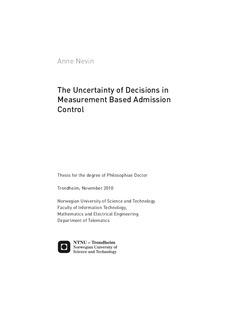| dc.contributor.author | Nevin, Anne | nb_NO |
| dc.date.accessioned | 2014-12-19T14:14:00Z | |
| dc.date.available | 2014-12-19T14:14:00Z | |
| dc.date.created | 2010-12-02 | nb_NO |
| dc.date.issued | 2010 | nb_NO |
| dc.identifier | 374045 | nb_NO |
| dc.identifier.isbn | 978-82-471-2423-9 (printed ver.) | nb_NO |
| dc.identifier.uri | http://hdl.handle.net/11250/262372 | |
| dc.description.abstract | Most real-time voice and video applications are delay/loss sensitive but relaxed in the sense that they can tolerate some packet loss/delay. Using this information, network utilization can be greatly improved by exploiting statistical multiplexing.
To this end, Measurement Based Admission Control (MBAC) has for a long time been recognized as a promising solution. MBAC algorithms, do not require an a priori source characterization which in many cases may be difficult or impossible to attain. Instead, MBAC uses measurements to capture the behavior of existing flows and uses this information together with some coarse knowledge of a new flow when making an admission decision for this requesting flow.
The number one requirement of MBAC to be successful is that it can robustly provide Quality of Service (QoS) to the accepted flows. Being robust means that MBAC must be able to withstand a sudden increase in the number of users trying to access the network, handle applications with various capacity requirements and handle an aggregate rate that may change in a highly unpredictable manner. These robustness issues become challenging since MBAC relies on erroneous measurements.
Measurements are unavoidably inaccurate. This imperfection creates uncertainties which affect the MBAC decision process. The degree of uncertainty depends on flow characteristics, the length of the observation window and the flow dynamics. Flows will be accepted when they should have been rejected, false acceptance , and rejected when they should have been accepted, false rejections. For the service provider, false rejections translate into a decrease in utilization and for the end user, false acceptance means that the QoS of the flow can no longer be guaranteed. Basing admissions on measurements clearly requires the understanding of the measurement error and how this impacts the performance of MBAC.
This thesis considers the uncertainty of the MBAC admission decision process and describes a methodology for analyzing measurement errors and the resulting performance of MBAC. When studying the performance of MBAC, the key is to focus on the time-scale over which measurements are collected and the admission decision is made. This is in contrast to the infinite time-scale used when evaluating the performance of MBAC with respect to utilization and loss/delay probabilities.
We find how the uncertainty in the measurements vary with the length of the observation window. Non-homogeneous flows cause increased complexity for the MBAC decision algorithm and also for the estimation process. The concept of similar flows is introduced, which is a restriction to simplify the analytical expressions in a non-homogeneous flow environment.
The probability of false acceptance can be reduced by adding a slack in bandwidth. When determining the size of this slack, the service provider is confronted with the trade-off between maximizing useful traffic and reducing useless traffic. We show how the system can be provisioned to meet predetermined performance criteria. This work is fundamentally different from any previous work concerning MBAC and opens up for new thinking and methods for analyzing MBAC performance. | nb_NO |
| dc.language | eng | nb_NO |
| dc.publisher | Norges teknisk-naturvitenskapelige universitet, Fakultet for informasjonsteknologi, matematikk og elektroteknikk, Institutt for telematikk | nb_NO |
| dc.relation.ispartofseries | Doktoravhandlinger ved NTNU, 1503-8181; 2010:218 | nb_NO |
| dc.title | The Uncertainty of Decisions in Measurement Based Admission Control | nb_NO |
| dc.type | Doctoral thesis | nb_NO |
| dc.contributor.department | Norges teknisk-naturvitenskapelige universitet, Fakultet for informasjonsteknologi, matematikk og elektroteknikk, Institutt for telematikk | nb_NO |
| dc.description.degree | PhD i Telematikk | nb_NO |
| dc.description.degree | PhD in Telematics | en_GB |
